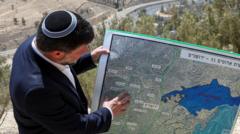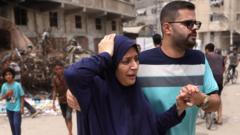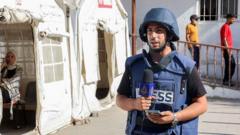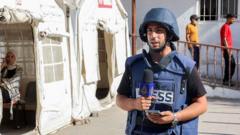The ongoing military operations in Gaza have resulted in significant destruction, intensifying fears over asbestos exposure in the rubble. Experts predict that the release of toxic fibers from asbestos, primarily found in older buildings, could lead to severe health issues like mesothelioma and other lung diseases over decades, complicating the region's recovery. Without awareness and preventive measures, the population may face a grim health crisis long after the conflict ends.
The Hidden Dangers of Asbestos in Gaza's Rubble: A Looming Health Crisis
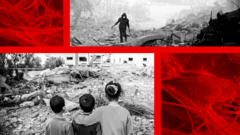
The Hidden Dangers of Asbestos in Gaza's Rubble: A Looming Health Crisis
As conflict devastates Gaza, experts warn of the silent threat posed by asbestos in the rubble, raising concerns over long-term health consequences.
The violence in Gaza has unleashed more than physical destruction; it has exposed the population to health hazards from asbestos lurking in the rubble. As noted by international health authorities, asbestos—a once-common building material long banned in some countries—remains present in older structures, particularly in the region’s refugee camps. The United Nations Environment Programme (UNEP) has warned that the conflict may yield 2.3 million tons of contaminated debris, threatening the community with long-term health effects.
Asbestos fibers, invisible to the naked eye, can be inhaled when disturbed. According to Professor Bill Cookson from the National Centre for Mesothelioma Research, asbestos can lead to serious ailments like asbestosis and aggressive lung cancers such as mesothelioma. Individuals may not exhibit symptoms until decades following exposure, with the disease presenting an especially daunting challenge due to its resistance to treatment. Dr. Ryan Hoy emphasizes the difficulty in avoiding asbestos, particularly in densely populated areas like Gaza, where the population density makes exposure more likely.
Compounding the issue is the immediate threat posed by ongoing military actions, which leads many residents to prioritize survival over understanding the concealed dangers of dust and particulates in their environment. Medical professionals in Gaza, such as Chiara Lodi from Médecins Sans Frontières, highlight a lack of awareness about these risks as families struggle to meet basic needs amid the ongoing conflict.
Following previous conflicts, evidence of asbestos in rubble from older structures has already been documented, presenting a helpfully grim context. Asbestos can vary in toxicity, with types like crocidolite being especially dangerous. Despite widespread bans, including in Israel since 2011, remnants of the material remain in many buildings.
Alongside the asbestos crisis, experts also warn of other respiratory hazards linked to dust exposure, which can exacerbate pre-existing conditions such as asthma and could lead to further health complications. The tragic implications of such pollution may extend far beyond the immediate dangers of armed conflict.
Efforts to reconstruct Gaza are underway, but the UN warns that debris removal must be handled with extreme care to avoid stirring up hazardous fibers. It has been estimated that a comprehensive cleanup could require up to 21 years and cost approximately $1.2 billion. The need for a coordinated and sensitive approach is critical, as echoed by Liz Darlison from Mesothelioma UK, who points to the vital nature of managing former hazards in the process of rebuilding lives.
As the scale of devastation grows amidst the ongoing violence, both local and international groups must prioritize raising awareness of these hidden dangers to ensure the long-term health of those who survive the immediate impacts of conflict.


